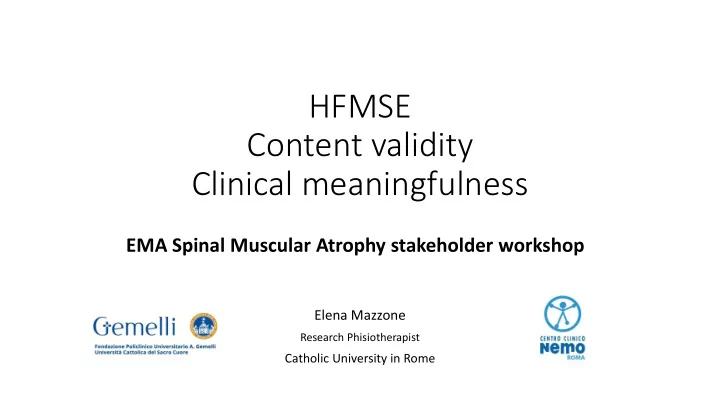

HFMSE Content validity Clinical meaningfulness EMA Spinal Muscular Atrophy stakeholder workshop Elena Mazzone Research Phisiotherapist Catholic University in Rome
DISCLOSURES SMA • CONSULTANT for: -IONIS Pharmaceuticals -BIOGEN -ROCHE -CYTOKINETICS • ADVISORY BOARD COMPANIES (Biogen, Roche) • SPEAKING AGREEMENTS (Biogen)
As clinicians was have been very often asked by regulators: -If what we measure with the outcome measures is clinically relevant - If acquiring/maintaining an ability on a scale is the same at different ends of disease spectrum or in different age groups CAN THE MEASURES WE ARE CURRENTLY USING MEASURE THESE CHANGES?
STUDY OBJECTIVES PHASE 1 EVALUATE CLINICAL RELEVANCE of HFMSE ITEMS IN REGARDS TO ADLs PHASE 2 EVALUATE CLINICAL MEANINGFULNESS of HFMSE CHANGES
PHASE 1 - FOCUS GROUPS : Content validity of HFMSE items QUALITATIVE STUDY conducted in Italy between June and October 2015 as part of a collaborative project with the two main Italian SMA advocacy groups 63 individuals participated in the focus groups PARENTS/CAREGIVERS PATIENTS 2-26 Years 17 Mothers & 13 Fathers 14-25 Years 5 Ambulant 3 Ambulant 25 Non ambulant 22 Non ambulant
Patients and caregivers were given a form describing the items of the HFMSE, with some pictures illustrating the activities included in the scale.
Patients and caregivers were given a form describing the items of the HFMSE, with some pictures illustrating the activities included in the scale. They were then asked to comment whether each activity assessed in the items could be related to activities of daily living, and if and why this was relevant to them.
SELF-CARE ACCESS AND PARTICIPATION IN SOCIAL ACTIVITIES INDEPENDENCE MOBILITY, TRANSFERS PLAY and EXPERIENCE
Results of the various groups were analyzed by assigning a code to each response and by identifying consistencies across the various groups tabulating the frequency of individual responses in the various subgroups. HMFSE activities Answers HMFSE Group 4 Group1 Group 2 Group 3 Patients ITEM Sitting on normal school chair or public spaces (stools in ● ● ● ● restaurant) ABLE TO SIT ON CHAIR OR WITH LEGS OFF BED Sitting on toilet ● ● ● 1 WITH OR WITHOUT HAND SUPPORT Sitting in car ● Independence out of the house ● ● ● Dress by herself/himself ● ● ● ● Play on floor with siblings ● ● Sit on lounge chair, deck-chair ABLE TO SIT ON FLOOR CROSS LEGGED OR LEGS ● ● 2 Picnic 64% OF ACTIVITIES 36% OF ACTVITIES STRETCHED IN FRONT ● Travel with less equipment ONLY 7 ● Inclusion in activities 66/103 37 /103 Wash face ● ● ● ● SUGGESTED BY Brush and style ● ● ● ● Eat ● ● SUGGESTED BY SUGGESTED BY 3 ABE TO BRING HANDS TO FACE AT EYE LEVEL Put on eye glasses ● ● ● PATIENTS ● Answer telephone > ONE GROUP ONLY ONE GROUP ● Blow nose ● ● ● ● Scratch head ● ● ● Wash, brush, style hair 4 ABE TO BRING HANDS TO HEAD ● ● ● Put on hat ● ● Dress upper body Sleep by myself in my own room ● ● 5 Caregiver does not have to wake up to turn him/her ● ● ● ROLL TO SIDE Help during dressing lying down ● ● Not having to turn head to see ● ● ● Play ● ● Sleep well ● ● 6-7-8-9 ROLL Sunbathe ● ● Experience space ● ● Reach for something at sides when lying down ● ● ● ● Independence: lye down and rest when tired Fun movement when falling ● ● 10 ABLE TO LYE DOWN FROM SITTING Rest on the back ● Safety: Fall in a controlled way (avoid head trauma) ●
PHASE 1 RESULTS Activities of the HFMSE, known to be relevant in clinical and research practice, are also clinically meaningful to patients and their caregivers Each activity included in the HFMSE was related to activities of daily living that were relevant to patients and their caregivers, as often suggested by many participants in more than one focus group.
PHASE 2 – Questionnaires/semi-structured interviews Clinical meaningfulness of HFMSE changes CENTERS UNIVERSITY OF POLICLINICO CENTRAL FLORIDA INTERNATIONAL COLLABORATIVE STUDY GEMELLI & NEMO ROME ORLANDO conducted from September 2015 to April 2016 STANFORD NEMO MESSINA UNIVERSITY 149 caregivers answered COLUMBIA UNIVERSITY GREAT ORMOND NEW YORK STREET LONDRA Age of patients: 17 months to 30 years HARVARD MEDICAL SCHOOL NEW CASTLE BOSTON UNIVERSITY 33 ambulant SMA III 7 non-ambulant SMA III 109 non ambulant SMA II
• Open questions covering possible changes that would be meaningful to the patients and their caregivers and their views and expectations regarding a possible participation in a clinical trial. • When HFMSE functional data of individual patients was available specific questions were tailored to patients’ functional level and were used to establish the caregivers view on the clinical relevance of HFMSE changes
“Would you agree to have your child take part in a potential trial if, prospective was to” Slow down a possible decline in motor function for at least two years? • Stop disease progression’ • Improve motor function • 97% 88% IMPROVE MOTOR STOP DETERIORATION FUNCTION
After being informed of the first three items that their child could not achieve on the HFMSE scale: “Would you consider taking part in a clinical trial if you had the prospective of achieving” More than 2 abilities At least 2 of the abilities At least 1 of the abilities 75% achieve 89% achieve 100% achieve at least at least > 2 ACTIVITIES 1 ACTIVITY 2 ACTIVITIES
STUDY RESULTS These studies appear to further support the use of the HFMSE as a robust outcome measure in clinical trials - individual items appear to be all meaningful to patients and carers - even minimal changes detected on the HFMSE scale, appear to be relevant and would justify participation in a clinical trial.
Recommend
More recommend